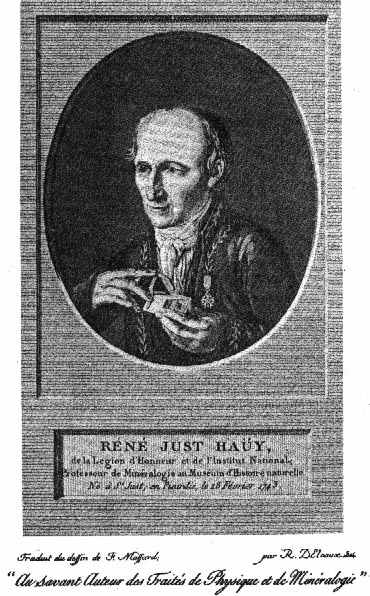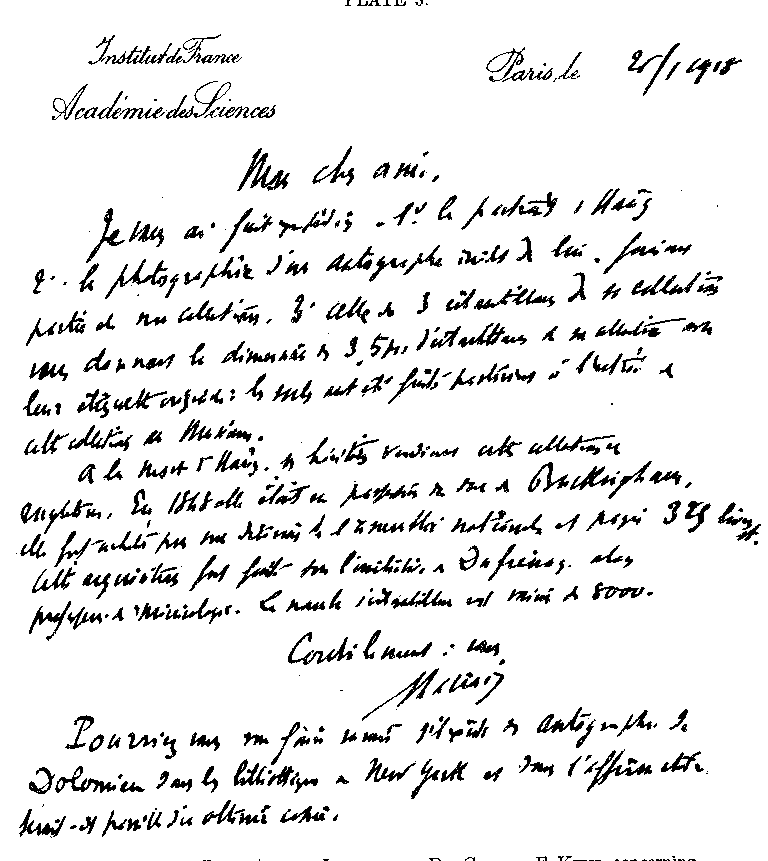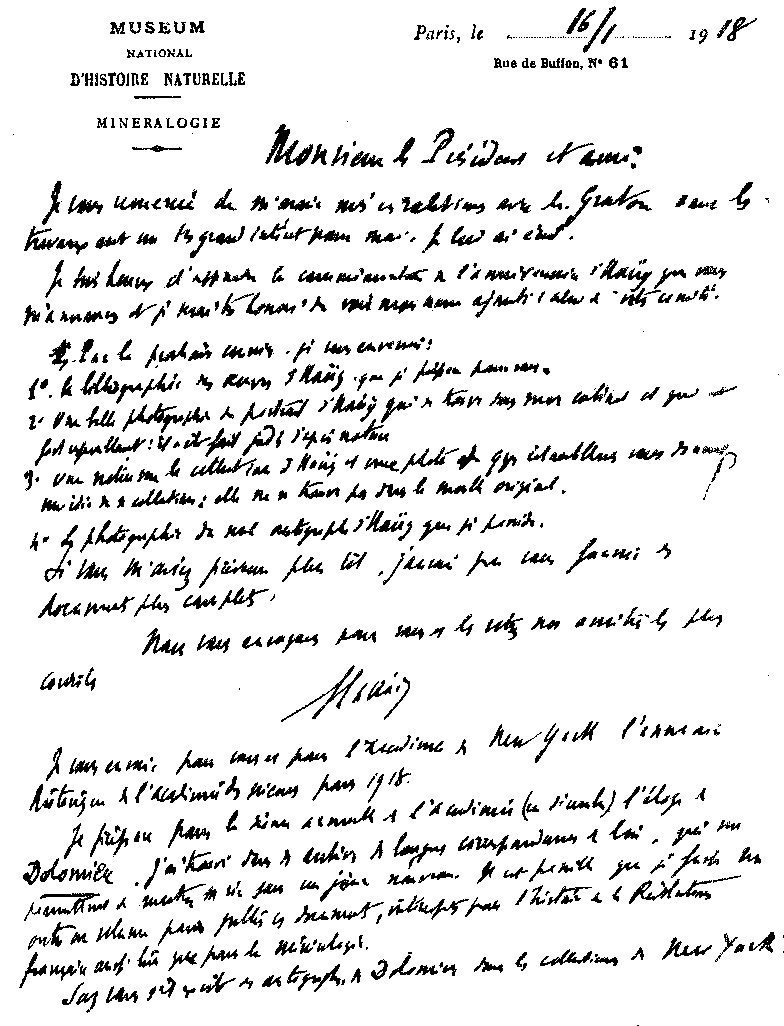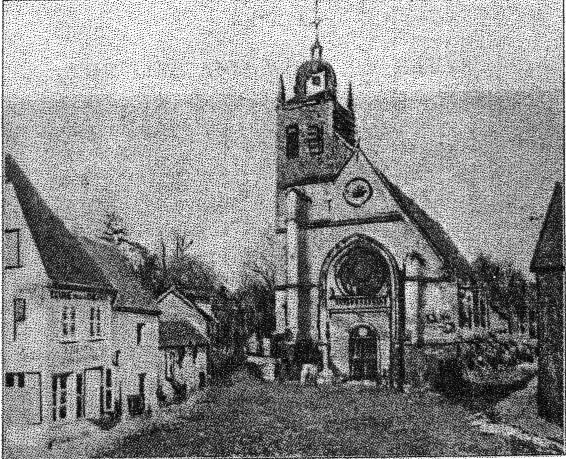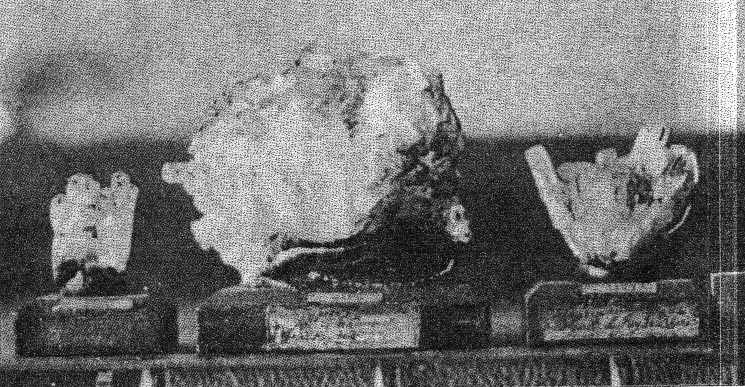| Home | AmMin | GMR | RiMG | Collectors Corner | Directory | Short Courses | |
|
|
|||||||

|
|
Volume 3, pages 49-60, 1918 THE ABBÉ RENÉ-JUST HAÜY CELEBRATION The Abbé Haüy Celebration, in honor of the 175th anniversary of the birth of this noted crystallographer, was held at the American Museum of Natural History on the evening of Thursday, February 28, 1918, under the auspices of the New York Mineralogical Club, jointly with the New York Academy of Sciences, Section E of the American Association for the Advancement of Science and other organizations. The chairman of the Committee, George F. Kunz, presided. Papers were presented by a number of the members of the Committee and one written for the Celebration by the late L. P. Gratacap was read in part. Addresses were made by R. A. A. Johnston, Alexander H. Phillips, J. Volney Lewis, Herbert P. Whitlock and others. An exhibition of books, portraits and other memorabilia was shown in two special cases in the Mineralogical Hall of the Museum [see list below]. A collection of books, prints and photographs was assembled in the Stuart Gallery of the New York Public Library, Fifth Avenue at 42d Street, and also at the New York State Library, Albany, N. Y. Preceding the meeting there was a banquet, given by the members of the Committee, in the Aztec Restaurant of the American Museum of Natural History, at which were present: George E. Ashby, David J. Atkins, Sydney H. Ball, George F. Black, Mrs. Wilda L. Brown, Raymond B. Earle, Axel O. Ihlseng, Kenzo Ikeda, Robert A. A. Johnston, George F. Kunz, Wallace Goold Levison, J. Volney Lewis, Frederick A. Lucas, James H. Mackintosh, A. Operti, Alexander H. Phillips, J. F. Quinn, Miss Catherine Schroder, Miss May L. Schroder, Gilman S. Stanton, Herbert P. Whitlock, and J. E. Woodman.
PLATE 2 The Massard-D'Elvaux portrait of Haüy. From "Tableau Méthodique des Espèces Minérales," by J. A. H. Lucas. Paris 1806. The menu was as follows: MENU Pea Soup à la Fouqué Filet de Sole, Fremy Grapefruit, Daubenton Whale Steak, Abbé Haüy Baked Potatoes, Dolomieu Hearts of Lettuce Salad, Michel Levy Pie and Ice Cream, Descloizeaux Demi-Tasse, Du Bournon COMMITTEE Honorary Chairman ALFRED LACROIX Professeur de Minéralogie au Muséum d'Histoire Naturelle, Paris, France (occupying the Chair of Abbé Haüy) *FRANK D. ADAMS, McGill University, Montreal, Canada. *JEROME ALEXANDER, New York Section of the Society of Chemical Industry. *GEORGE E. ASHBY, New York Microscopical Society. *SYDNEY H. BALL, American Institute of Mining Engineers. ERWIN H. BARBOUR, University of Nebraska, Lincoln, Neb. CLARENCE S. BEMENT, Mineralogist. *CHARLES P. BERKEY, American Association for the Advancement of Science (Section E). *GEORGE F. BLACK, New York Public Library. FRANK W. CLARKE, U. S. Geological Survey. *CHARLES A. COLTON, Newark Technical High School. EDWARD S. DANA, Yale University, New Haven, Conn. *MARY C. DICKERSON, American Museum of Natural History, N. Y. ARTHUR S. EAKLE, University of California, Berkeley. *R. B. EARLE, New York Academy of Sciences. *OLIVER C. FARRINGTON, Field Museum of Natural History, Chicago. *GEORGE I. FINLAY, New York Academy of Sciences. WILLIAM E. FORD, Sheffield Scientific School, Yale University, New Haven, Conn. *SAMUEL G. GORDON, Academy of Natural Sciences, Philadelphia, Pa. *McDOUGALL HAWKER, Museum of French Art, Institut Français aux Etats Unis. WILLIAM H. HOBBS, University of Michigan, Ann Arbor, Michigan. W. O. HOTCHKISS, State Geologist, Wisconsin. *EDMUND O. HOVEY, New York Academy of Sciences, American Association for the Advancement of Science (Section E). *AXEL O. IHLSENG, American Institute of Mining Engineers. *KENZO IKEDA, Imperial University of Tokyo, Japan. *ROBERT A. A. JOHNSTON, Geological Survey of Canada, Ottawa, Canada. *EDWARD H. KRAUS, University of Michigan, Ann Arbor. HENRY B. KUMMEL, State Geologist, New Jersey. *GEORGE F. KUNZ, New York Mineralogical Club, American Scenic and Historic Preservation Society, Museum of French Art, Institut Français aux Etats-Unis. *WALLACE GOOLD LEVISON, Brooklyn Institute of Arts and Sciences. *J. VOLNEY LEWIS, State University of New Jersey, New Brunswick. *FREDERIC A. LUCAS, American Museum of Natural History. LEA MCI. LUQUER Columbia University, N. Y. *JAMES G. MANCHESTER, New York Mineralogical Club. DANIEL S. MARTIN, Charleston Museum, Charleston, S. C. *E. B. MATHEWS, Johns Hopkins University, Baltimore, Md. GEORGE P. MERRILL, U. S. National Museum, Washington, D. C. *BENJ. L. MILLER, Lehigh University, South Bethlehem, Pa. *ALFRED J. MOSES, Columbia University, New York. CHARLES PALACHE, Harvard University, Cambridge, Mass. ARTHUR L. PARSONS, University of Toronto, Canada. *ALEXANDER H. PHILLIPS, Princeton University, New Jersey. JOSEPH E. POGUE, U. S. National Museum, Washington, D. C. WASHINGTON A. ROEBLING, Mineralogist. AUSTIN F. ROGERS, Leland Stanford Junior University, California. *G. A. ROUSE, Lehigh University, South Bethlehem, Pa. *WALDEMAR T. SCHALLER, U. S. Geological Survey. *JOSEPH T. SINGEWALD, JR., Johns Hopkins University, Baltimore, Md. *GILMAN S. STANTON, New York Mineralogical Club. *C. H. SWARTZ, Johns Hopkins University, Baltimore, Md. *ARTHUR C. TERRILL, University of Kansas, Lawrence, Kan. *RALPH W. TOWER, American Museum of Natural History. *ALEXANDER VACHON, Univérsité Laval, Quebec. FRANK R. VAN HORN, Case School of Applied Science, Cleveland, O. HENRY S. WASHINGTON, Geophysical Laboratory, Washington, D. C. EDGAR T. WHERRY, Bureau of Chemistry, U. S. Department of Agriculture, Washington, D. C. *JOSEPH P. WINTRINGHAM, New York Mineralogical Club. *J. EDMUND WOODMAN, American Association for the Advancement of Science (Section E). GEORGE F. KUNZ, Chairman, 405 Fifth Avenue, New York City. HERBERT P. WHITLOCK, Secretary, The New York State Museum, Albany, N. Y. *Official Appointment. Editing Committee: George F. Kunz, Herbert P. Whitlock and Edgar T. Wherry.
HAÜY EXHIBITION AT THE AMERICAN MUSEUM OF NATURAL HISTORY Mineral Specimens: Varieties of amphibole: Tremolite . . . . . . . . . . . . . . . . . . . . . . . . . . Canaan, Conn. Actinolite . . . . . . . . . . . . . . . . . . . . . . . . . . Blanford, Mass. Hornblende . . . . . . . . . . . . . . . . . . . . . . . . Norway. These were formerly considered separate species, but were united into a single group by Haüy. Mineral species and varieties separated and described by Abbé Haüy Euclase . . . . . . . . . . . . . . . . . Villa Rica, Brazil. Iolite (Dichroite) . . . . . . . . . Bodenmais, Bavaria. Staurolite . . . . . . . . . . . . . . . Mt. Campione, Switzerland. Two specimens of azurite, with original presentation label, signed by Haüy. Loaned by Columbia University. Specimen. Cleavage rhombohedron of calcite, similar to the one which suggested to Haüy his great discovery. Cleavage fragments of calcite, showing the way in which this mineral breaks. A crystal of calcite similar to the one accidentally broken by Haüy in the collection of Citoyen Defrance du Croisset. A goniometer similar to that used by Haüy. Loaned by the New York State Museum. Five specimens of haüynite 1. From Vesuvius. 2. " Marion, Italy 3. " Mt. Somma. 4. " Niedermendig, Germany. 5. " Vesuvius. Haüynite: It is interesting to observe that a tribute has been paid to the genius of Haüy by Bruun-Neergard in 1807 in the naming of a silicate mineral in honor of this world-renowned scientist. The mineral named haüynite or haüyne, after Haüy, is a complex silicate of sodium, calcium and aluminum, belonging to the sodalite group. It occurs frequently in the lavas of Mt. Vesuvius and crystallizes in the isometric system. The hardness is from 5.5 to 6, and the specific gravity is about 2.45. The mineral is generally translucent, and the luster vitreous. The coloration varies in different examples, red and yellow being, however, rare, while. specimens of blue. or green hue are usual. Portraits of Abbé Haüy: [Plates 2, 6, 7, 8, 9, 10, and 11.] 1. Sent by Prof. Alfred Lacroix. Copy of one in his possession. 2. By Ambroise Tardieu, French engraver, 1788-1841. 3. By Johann Anton Riedel, engraver, 1733-1816; after F. Massard. Print published about 1812. 4. By Félix Massard. Engraver, R. Delvaux. 1748-1823.
5. Abbé René-Just Haüy From the George F. Kunz Collection at the 6. The Haüy Freres Portrait of Valentin Haüy, brother of Abbé Haüy, well known as the founder of the Institution of Jeunes-Aveugles, similar forms of which he established in Russia and Germany. Autographs: [Plate 12.]
Photographic reproduction of the title-page of "Des Surfaces Vibrantes" given by Abbé Haüy to Dr. J. G.
Cogswell, the first librarian of the Astor Library, now the New York Public Library (now in the possession of the
Library), with photographic reproduction of the inscription, which reads: Original letter of Abbé Haüy, written on the 4th of September, 1813, to one Monsieur Marron. Property of George F. Kunz. Photographic reproduction of a letter in the possession of Professor Alfred Lacroix, with signature of Haüy. Reproduction of a facsimile letter from the "Isographie des Hommes Célèbres," asseinbled by T. Delarue. Paris, 1843.
PLATE 3. Letter from Prof. Alfred Lacroix, to Dr. George F. Kunz, concerning Haüy mementoes.
PLATE 4. Postcard from Prof. Alfred Lacroix, announcing the sending of Haüy souveniers, and giving particulars as to Haüy's collection of minerals. Books:
1. "Exposition Raisonée de la Théorie de l'Electricité et du Magnétisme." Paris, 1787.
2. "Traité Elémentaire de Physique" (Elementary treatise on Physics). Abbé Haüy. Paris, 1803.
3. "Traité de Minéralogie." Abbé Haüy. Paris, 1801.
4. "Tableau Comparatif des Résultats de la Cristallographie et de l'Analyse Chimique." Abbé Haüy. Paris, 1809.(2 copies shown.)
5. "Traité des Caractères Physiques des Pierres Précieuses." Abbé Haüy. Paris, 1817. (2 copies.) 6 Italian Translation by Luigi Configliachi of "Traité des Caractères Physiques des Pierres Précieuses." Milano, 1819. (2 copies.)
7. "Mémoire Sur le Pyroxène Analogique." Abbé Haüy,
Paris, 1819. Extrait des Annales des Mines.
8. Copy of the Mémoires de l'.Académie Royale
des Sciences, showing articles written by Haüy- 9. Copy of the Mémoires de l'Académie Royale des Sciences, showing the Memorial Eulogy on Abbé Haüy delivered by Baron Cuvier, June 2, 1823.
10. A text book of the period just prior to the influence of Haüy, published in England in 1771. (Loaned by Herbert P.
Whitlock.)
11. Catalog of Scientific Papers of the Royal Society of London. Bibliography: 1. Photographic reproduction of bibliography (Royal Society of London, showing also pages 232 and 233.) 2. Photographic reproduction of pp. 1038, 1039, and 1040 of the "Biographisch-Literarisches Handwörterbuch." J. C. Poggendorff, Leipzig, 1863. Vol. 1. (Giving bibliography of Abbé Haüy.) The biographical notice of the honorary chairman of the celebration in the French annual Qui êtes-vous (Who's who) runs as follows: Lacroix, Alfred. Born -February 4, 1863, at Macon (Saône-et Loire). Chevalier de la Légion d'Honneur. Membre de
l'Institute (1904), professeur at the Muséum d'Histoire Naturelle (1893), director of the Laboratory of Mineralogy, of the
École
des Hautes Êtudes. Docteur ès sciences. Préparateur au Collège de France (1887); head of the Mission Scientifique de la Martinique (1902-1903); many scientific missions (United States and Canada, Asia Minor, Greece, Italy, Germany, England; member of the Comite des Travaux Historiques et Scientifiques (1895), and of the Commission de la Carte Géologique de France (1906). Honorary or corresponding member of the mineralogical societies of London and St. Petersburg and the Geological Society of London. Works: Minéralogie de la France, five volumes, 1893-1902. Les Enclaves des roches volcaniques. La Montagne Pelée et ses eruptions, 1904. (And numerous scientific papers.) Lauréat de l'Institut (1892-1093) and of the Société de Géographie (1904). Sécretaire Perpétuel of the Section of Physics in the Académie des Sciences (from 1914).1 Prof. Lacroix occupies the curatorship of the mineralogical cabinet of the Muséum d'Histoire Naturelle. He was elected a member of the Académie des Sciences, section de mineralogie, in 1904. The collection of the Muséum d'Histoire Naturelle2 is the greatest in France and is of unusual interest because, dating from 1793, it has had as its administrators some of the greatest of France's mineralogists. Since its foundation in 1793, the collection has been under the following: Daubenton (1793-1800), Dolomieu (1800-1802), Haüy (1802-1822), Alex. Brongniart (1822-1847), Dufrenoy (1847-1857), Delafosse (1857-1876), Des Cloizeaux (1876-1893). Since 1893, Professor A. Lacroix (b. 1863), Secrétaire perpétuel de l'Académie des Sciences, has been the administrator of the collection. The collection itself is made up of numerous important aggregates: Chantilly Collection (1793), Weiss Collection (1802), Brongniart Collection (1823), Sage Collection, Cabinet de la Monnaie (1825), Gillet de Laumont Collection, including the Romé de l'Isle Collection (1835), Bischoffsheim Collection (1890), Des Cloizeaux Collection (1904), Ch. Frossard Collection (1908), J. Pierpont Morgan Collection (1902-1913). A portion of the collection of Des Cloizeaux comprehends types of his varied work and exists in the general collections. The Haüy Collection contains many of his original specimens, which he described from time to time. The Muséum collections are arranged in 15 groups and are contained in 192 cases. The catalog contains 132 octavo pages and one folding plan of the arrangement of the collection. The alphabetical index of 41 pages is most excellent and greatly facilitates reference. In the Haüy Collection, placed in the entrance hall, there are nearly 8,000 specimens, all the labels of which are in the handwriting of Abbé Haüy and displayed near the collection models. Two cases in the same hall with the Haüy specimens contain a series of crystallographic models made under the direction of Romé de l'Isle, in accordance with the figures in his Traité de Cristallographie published in 1783. The following pages contain the papers contributed for the Haüy Celebration, and in part read at the meeting; they have been arranged and edited by Dr. Edgar T. Wherry. The publication of the Haüy proceedings and papers in this magazine has been made possible by the generous aid of Colonel William Boyce Thompson of New York City, whose interest in mineralogy and scientific; research is well known. 1 Since the reorganization of the Académie in 1803, under Napoleon as First Consul, there have been only seven secrétaires perpétuels for the division of Mathematical Sciences, namely:
1803. Delambre.................Astronomer.
2 Collection de Minéralogie, Guide du Visileur, par A. Lacroix, 3d ed., 132 pp., folding plan, Paris, 1915.
Old church at St. Just-en-Chaussée, where Haüy was choirister in his childhood; from biography of Haüy in the series "Les Contemporians."
Specimens from the Haüy collection at the Muséum d'Histoire Naturelle, Paris, with Haüy's original labels in his own handwriting. Photographed in the Museum for Haüy celebration at the American Museum of Natural History. New York, February 28, 1918.
|
